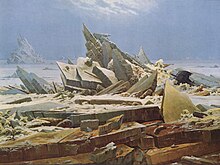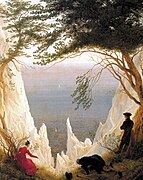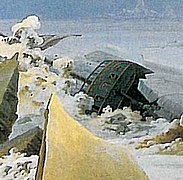Kaspar David Fridrih
| Kaspar David Fridrih | |
|---|---|
 Kaspar David Fridrih iz oko 1810. | |
| Datum rođenja | 5. septembar 1774. |
| Mesto rođenja | Grajfsvald Švedska Pomeranija |
| Datum smrti | 7. maj 1840. (65 god.) |
| Mesto smrti | Drezden Nemačka konfederacija |
| Prebivalište | Kopenhagen, Drezden |
| Državljanstvo | Nemačko |
| Delovanje | slikarstvo, crtež, grafika |
Kaspar David Fridrih (5. septembar 1774, Grajfsvald – 7. maj 1840, Drezden) bio je nemački slikar i grafičar. Najvažniji je predstavnik romantizma u Nemačkoj i često smatran za najvažnijeg nemačkog umjetnika svoje generacije.[1]

Friedrichovo prvo važnije delo koje raskida s tradicijom prikazivanja oltarnog krsta smeštajući ga u krajolik.
Životopis
[уреди | уреди извор]
Kaspar David Fridrih je rođen kao šesto od desetero djece u Grajfsvaldu, lučkom gradiću u Švedskoj Pomeraniji koji su Prusi anektirali 1815. god. Detinjstvo mu je obeleženo tragedijom: majka mu je umrla kad mu je bilo sedam godina, mlađa mu je sestra umrla sa samo dvadeset meseci, a brat se utopio pokušavajući mu spase život u nesreći na klizanju. Studirao je kod J. G. Kvistropa na kopenhagenskoj Akademiji umetnosti, jednoj od najvažnijih u Evropi, a potom se preselio u Drezden (1798). Zajedno s Filipom Otom Rundgeom, Kaspar Fridrih je važan i za književni krug oko Hajnriha fon Klajsta, Novalisa i drugih nemačkih romantičarskih književnika. Njegovim slikama su se divili prijatelj Gete, a otkupljivao ih je pruski kralj Fridrih Vilhelm III, na nagovor petnaestogodišnjeg princa, koji je kasnije postao Fridrih Vilhelm IV, a kupovali su ih i car Nikola i veliki knez Aleksandar. Uprkos toga Fridrih je umro u siromaštvu, i to „napola lud”.[2] Sahranjen je na groblju Svetog trojstva u Drezdenu.
Nisam toliko slab da podlegnem zahtevima svog vremena koje je u suprotnosti s mojim uverenjima. Ja stvorim čauru oko sebe i puštam da drugi urade to isto. Ostaviću vremenu da pokaže šta će od toga biti: sjajni leptir ili crv.
— [3]
Proslavljen je tek u kasnom 19. veku, a do 1920-ih njegove slike su otkrili ekspresionisti, a 1930-ih i nadrealisti i egzistencijalisti. Usponom nacizma ranih 1930-ih isticana je njegova vrednost, a padom nacizma palo je i zanimanje za njegove slike jer su doživljavane kao nacionalističke. Tek je 1970-ih K. D. Fridrih ponovno priznat kao ikona nemačkog romantičarskog pokreta i slikar međunarodnog značaja.
Dela
[уреди | уреди извор]
Prva dela K. D. Fridrih je radio u sepiji i crtežu, a u ulju ostvaruje impozantni Tretschen-Altar (Krst u planini). Najveći domet postiže u krajolicima, magličastim marinama, prizorima brodova, stena, ledenih santi, gotskih ruševina, i to stvaranjem određene atmosfere, služeći se simboličnim elementima (Brodolom Nade; Krajolik s dugom; Grejsvaldska luka). Naročitu pažnju je poklanjao nijansama boja. U Fridrihovim slikama čovek je često smešten u omalovažavajućem položaju naspram dominantnog krajolika (Lutalica iznad mora magle) koji, po rečima istoričara Kristofera Džona Marija, „upravlja gledaočevim pogledom prema metafičkim dimenzijama”.[4]
Njegov savremenik, francuski kipar David d'Anže (1788–1856) ga je opisao kao čoveka koji je pronašao „tragediju krajolika”.[5]
Ono što slikari krajolika vide u stotinu stupnjeva okolne prirode pokušavaju bez milosti utisnuti u vidik od 45 stupnjeva. Nadalje, ono što je u prirodi razdvojeno velikim prostorima, ugužvano je u prostor koji se preliva i preopterećuje oko, stvarajući neugodan i neukusan uticaj na gledaoca.
— Mitchell, Timothy (1984). „Caspar David Friedrich's der Watzmann: German Romantic Landscape Painting and Historical Geology”. The Art Bulletin. 66 (3): 452—464. JSTOR 3050447. doi:10.2307/3050447.
-
Krajolik s dugom, 1810, 59 × 84.5 cm, nepoznata lokacija. -
Opatija među drvećem, 1810, 110.4 × 171 cm, Sve-državna galerija, Berlin. -
Bele stene iznad Rigena, 1818, 90.5 × 71 cm, muzej Oskar Reinhart am Stadtgarten, Vintertur, Švajcarska. -
Mesečina iznad mora, 1822, 55 × 71 cm, Svedržavna galerija, Berlin. -
Detalj Brodoloma Nade
-
Hrast u snegu, 1829, 71 × 48 cm, Svedržavna galerija, Berlin.
-
Veliki kružni kanal kod Drezdena, 1832, 73,5 × 102,5 cm, Nova galerija majstora, Drezden -
Meditacija na mesečini, 1835, 34 × 44 cm, Svedržavna galerija, Berlin. -
Riesengbirge, 1835, 73,5 × 102,5 cm, Svedržavna galerija, Berlin. -
Veče, 1821, 22,3 × 31 cm, Donjosaski zemaljski muzej Hanover.
Reference
[уреди | уреди извор]- ^ Vaughan, William (1980). German Romantic Painting. New Haven: Yale University Press. стр. 65. ISBN 978-0-300-02387-9.
- ^ Miller, Philip B. (1974). „Anxiety and Abstraction: Kleist and Brentano on Caspar David Friedrich”. Art Journal. 33 (3): 205—210. JSTOR 775783. doi:10.2307/775783.
- ^ John Russell, Art born in the fullness of age, The New York Times, 23. kolovoza 1987.
- ^ Christopher John Murray (2004). Encyclopedia of the Romantic Era, 1760-1850. London: Taylor & Francis. стр. 338. ISBN 978-1-57958-422-1.
- ^ Vaughan, William (2004). Friedrich. Oxford, Oxfordshire: Phaidon Press. ISBN 978-0-7148-4060-4.
Literatura
[уреди | уреди извор]- Boele, Vincent; Asvarishch, Boris (2008), Boele, Vincent; Foppema, Femke, ур., Caspar David Friedrich and the German Romantic Landscape, Amsterdam: Hermitage Amsterdam, ISBN 978-90-400-8568-0
- Boime, Albert (1990), Art in an Age of Bonapartism, 1800–1815: A Social History of Modern Art, 2, Chicago: University of Chicago Press, ISBN 978-0-226-06335-5
- Busch, Werner (2003), Caspar David Friedrich: Ästhetik und Religion, Munich: C.H. Beck, ISBN 978-3-406-50308-5
- Dahlenburg, Birgit; Carsten, Spitzer (2005), „Major Depression and Stroke in Caspar David Friedrich”, Ур.: Bogousslavsky, Julien; Boller, François, Neurological Disorders in Famous Artists, Frontiers of Neurology and Neuroscience, 19, Basel: S. Karger AG (Switzerland), стр. 112—120, ISBN 978-3-8055-7914-8, doi:10.1159/000085609
- Grave, Johannes (2012), Caspar David Friedrich, London: Prestel, ISBN 978-3791346281
- Griffiths, Antony; Carey, Francis (1994), German Printmaking in the Age of Goethe, London: British Museum Press, ISBN 978-0-7141-1659-4
- Guillaud, Maurice; Guillaud, Jacqueline, ур. (1985), Caspar David Friedrich, line and transparency – Exhibition catalogue, Centre Culturel du Marais, Paris, New York: Rizzoli International Publications, ISBN 978-0-8478-5408-0
- Friedrich, Caspar David (1984), Hinz, Sigrid, ур., Caspar David Friedrich in Briefen und Bekenntnissen, Berlin: Henschelverlag, ISBN 978-3-8077-0019-9
- Hofmann, Werner (2000), Caspar David Friedrich, London: Thames & Hudson, ISBN 978-0-500-09295-8
- Johnston, Catherine; Leppien, Helmut R.; Monrad, Kasper (1999), Baltic Light: Early Open-Air Painting in Denmark and North Germany, New Haven: Yale University Press, ISBN 978-0-300-08166-4
- Koerner, Joseph Leo (1990), Caspar David Friedrich and the Subject of Landscape, New Haven: Yale University Press, ISBN 978-1-86189-439-7
- Rewald, Sabine (2001), Caspar David Friedrich: Moonwatchers, New York: The Metropolitan Museum of Art, ISBN 9780300092981
- Rosenblum, Robert; Asvarishch, Boris I. (1990), Rewald, Sabine, ур., The Romantic Vision of Caspar David Friedrich: Paintings and Drawings from the U.S.S.R, New York: Metropolitan Museum of Art, ISBN 978-0-87099-603-0 (essays)
- Rosenblum, Robert (1975), Modern Painting and the Northern Romantic Tradition: Friedrich to Rothko, New York: Harper & Row, ISBN 978-0-06-430057-5
- Siegel, Linda (1978), Caspar David Friedrich and the Age of German Romanticism, Boston: Branden Publishing Co, ISBN 978-0-8283-1659-0
- Vaughan, William (1972), Caspar David Friedrich, 1774–1840: Romantic Landscape Painting in Dresden – Catalogue of an Exhibition Held at the Tate Gallery, London, 6 September – 16 October 1972, London: Tate Gallery, ISBN 978-0-900874-36-9
- Vaughan, William (1980), German Romantic Painting, New Haven: Yale University Press, ISBN 978-0-300-02387-9
- Vaughan, William (2004), Friedrich, Oxford Oxfordshire: Phaidon Press, ISBN 978-0-7148-4060-4
- Werner, Christoph (2006), Um ewig einst zu leben. Caspar David Friedrich und Joseph Mallord William Turner (на језику: German), Weimar: Bertuch Verlag, ISBN 978-3-937601-34-2
- Wolf, Norbert (2003), Caspar David Friedrich, Köln: Taschen, ISBN 978-3-8228-2293-7
- Academic American Encyclopedia. 3. Los Angeles: Grolier. 2008. ISBN 978-0717-22024-3.
- Beenken, Hermann (1938). „Caspar David Friedrich”. The Burlington Magazine for Connoisseurs. 72 (421). JSTOR 867281.
- Börsch-Supan, Helmut (1972). „Caspar David Friedrich's Landscapes with Self-Portraits”. The Burlington Magazine. 114 (834). JSTOR 877126.
- Börsch-Supan, Helmut (1974). Caspar David Friedrich
 . Twohig, Sarah (tr.). New York: George Braziller. ISBN 978-0-8076-0747-3.
. Twohig, Sarah (tr.). New York: George Braziller. ISBN 978-0-8076-0747-3. - Causey, Andrew (1980). Paul Nash. Oxford: Clarendon Press. ISBN 978-0-1981-7348-9.
- Clark, Kenneth (2007). Landscape into Art. London: Gibb Press. ISBN 978-1-4067-2824-8.
- Elger, Dietmar (2009). Gerhard Richter: A Life in Painting. Chicago: University of Press. ISBN 978-0-2262-0323-2.
- Forster-Hahn, Françoise (март 1976). „Recent Scholarship on Caspar David Friedrich”. The Art Bulletin. 58 (1). JSTOR 3049469.
- Grewe, Cordula (мај 2006). „Heaven on Earth: Cordula Grewe on Caspar David Friedrich”. Artforum International. 44 (9).
- Miller, Philip B. (1974). „Anxiety and Abstraction: Kleist and Brentano on Caspar David Friedrich”. Art Journal. 33 (3). JSTOR 775782.
- Mitchell, Timothy (септембар 1984). „Caspar David Friedrich's Der Watzmann: German Romantic Landscape Painting and Historical Geology”. The Art Bulletin. 66 (3). JSTOR 3050447.
- Murray, Christopher John (2004). Encyclopedia of the Romantic Era, 1760–1850
 . London: Taylor & Francis. ISBN 1-57958-422-5.
. London: Taylor & Francis. ISBN 1-57958-422-5. - Prettejohn, Elizabeth (2005). Beauty & Art, 1750–2000. Oxford: Oxford University Press. ISBN 978-0-1928-0160-9.
- Schmied, Wieland (1995). Caspar David Friedrich. New York: H.N. Abrams. ISBN 978-0-8109-3327-9.
- Schmitz, Matthias (1940). Caspar David Friedrich: His Life and Work. German Library of Information.
- Schütz, Sabine (1991). „Color-Space Bodies: The Art of Gotthard Graubner”. Arts Magazine. 65.
- Siegel, Linda (1974). „Synaesthesia and the Paintings of Caspar David Friedrich”. The Art Journal. 33 (3): 196—204. JSTOR 775782. doi:10.1080/00043249.1974.10793214.
Spoljašnje veze
[уреди | уреди извор]all from Smarthistory |
- Fundacija Caspar David Friedrich
- Hermitage Museum Archive
- Caspar David Friedrich in historic European newspapers
- CasparDavidFriedrich.org Архивирано на сајту Wayback Machine (3. април 2009) – 89 paintings by Caspar David Friedrich
- Biographical timeline, Hamburg Kunsthalle
- Caspar David Friedrich and the German romantic landscape
- German masters of the nineteenth century: paintings and drawings from the Federal Republic of Germany, a full text exhibition catalog from The Metropolitan Museum of Art, which contains material on Caspar David Friedrich (no. 29-36)
| Međunarodne | |
|---|---|
| Državne | |
| Akademske | |
| Umetničke | |
| Ljudi | |
| Ostale | |
Text is available under the CC BY-SA 4.0 license; additional terms may apply.
Images, videos and audio are available under their respective licenses.










